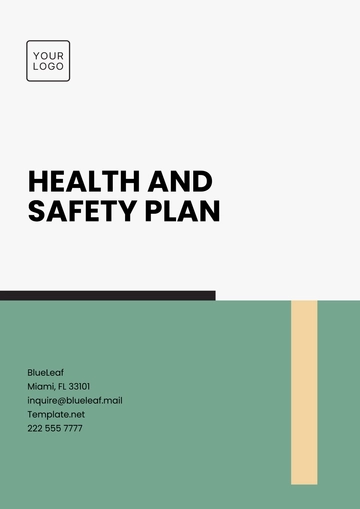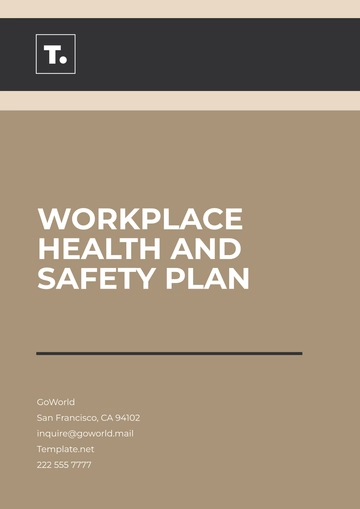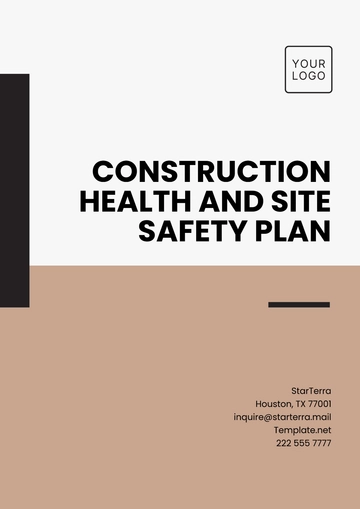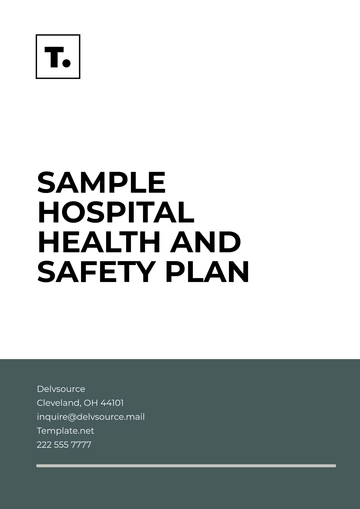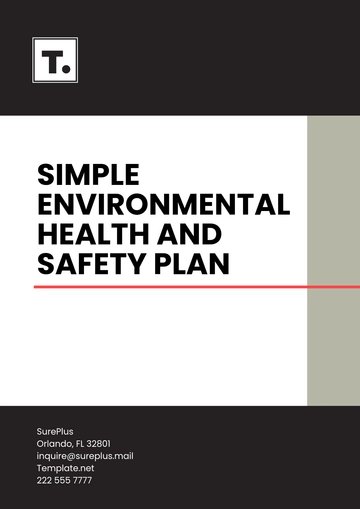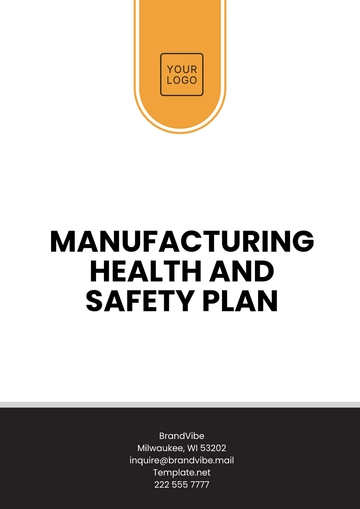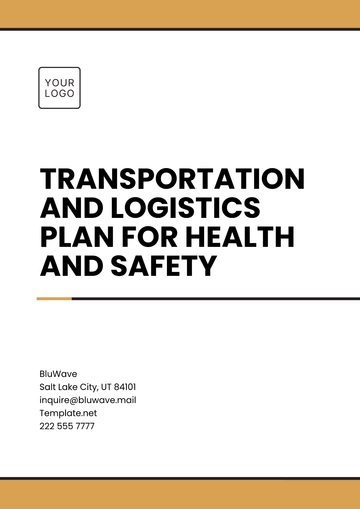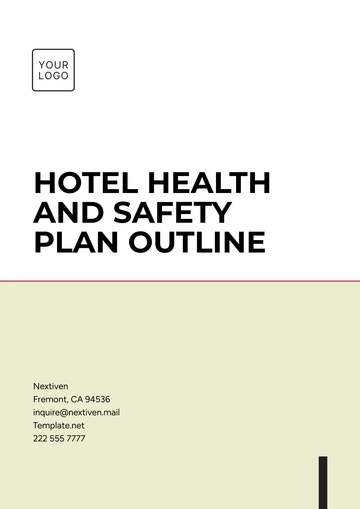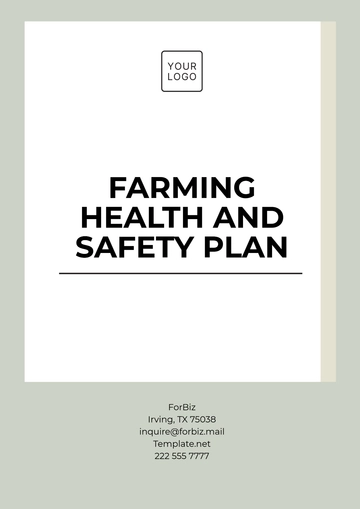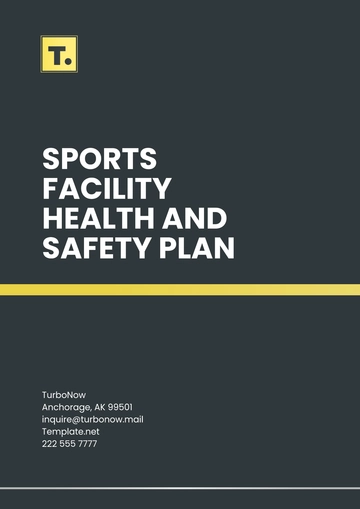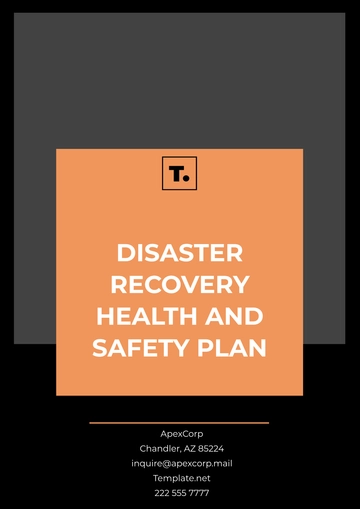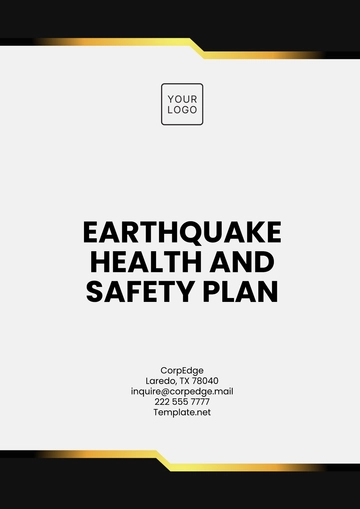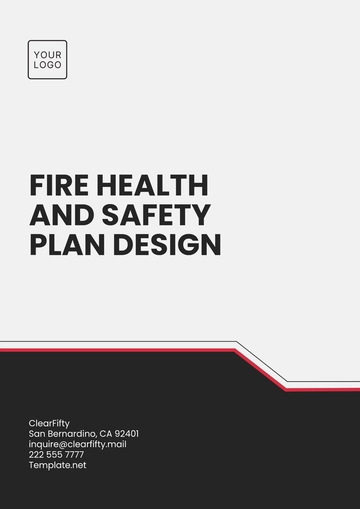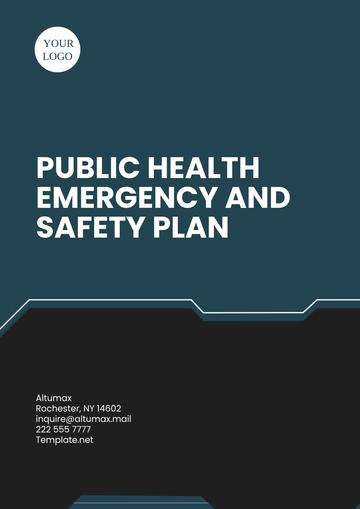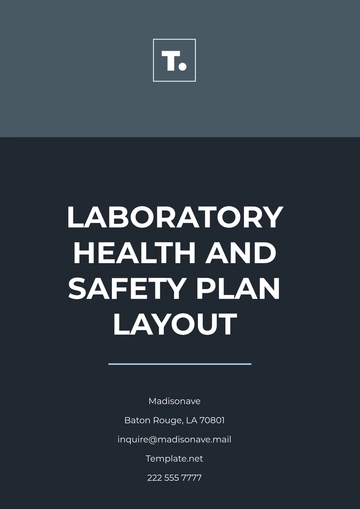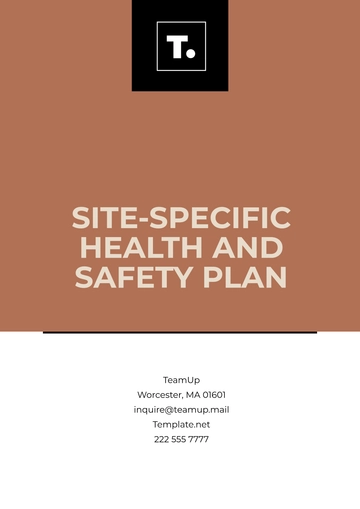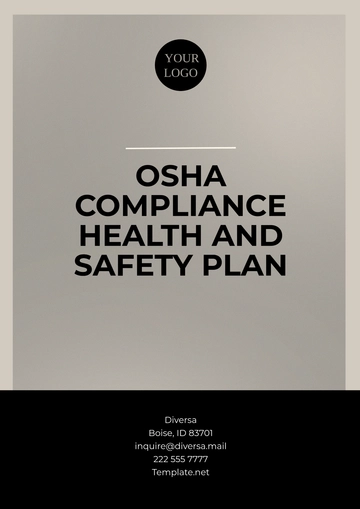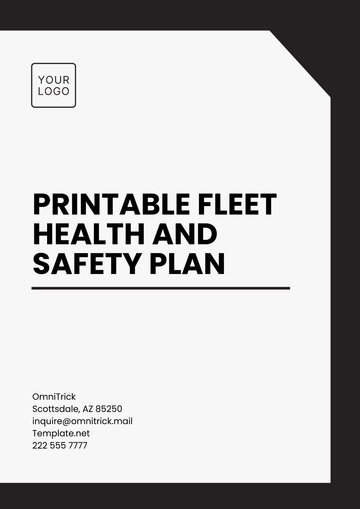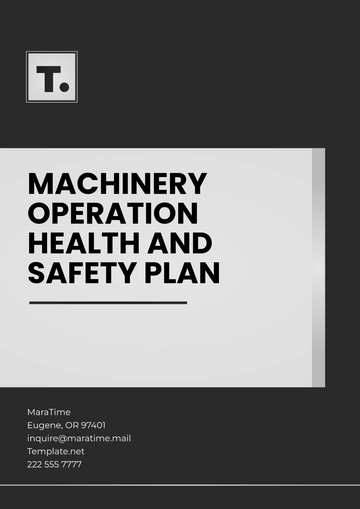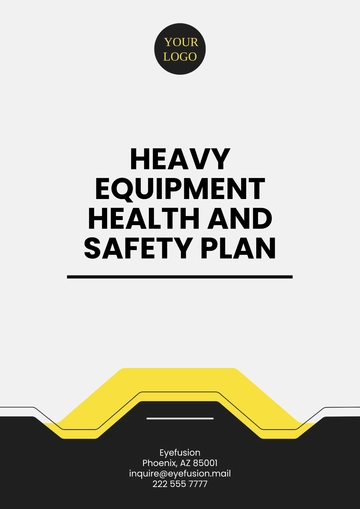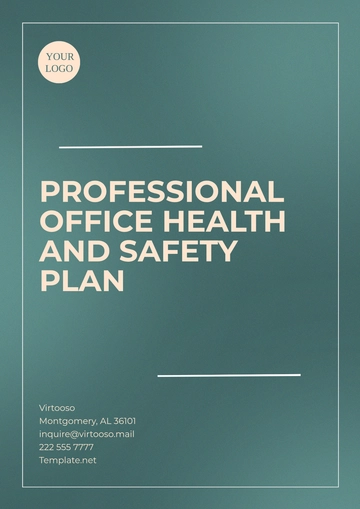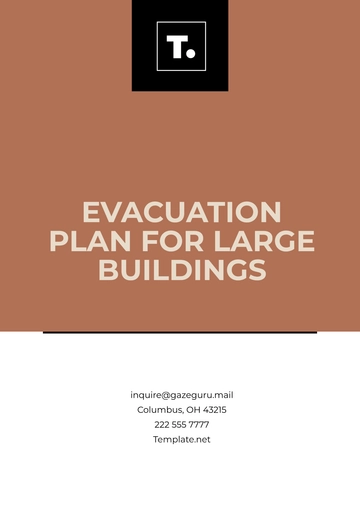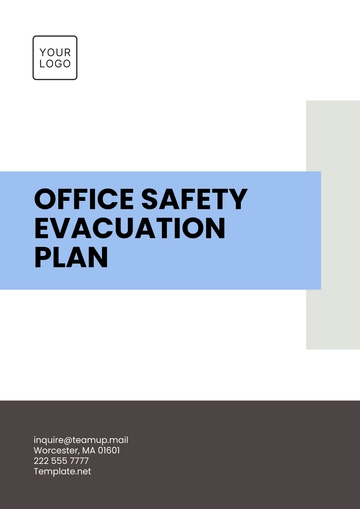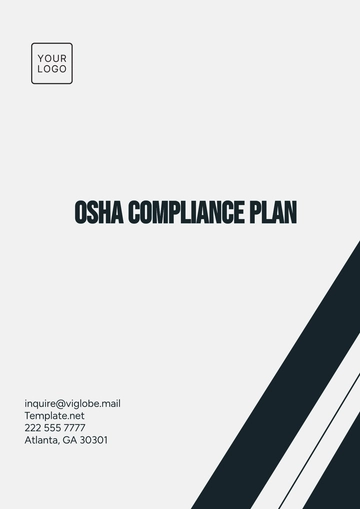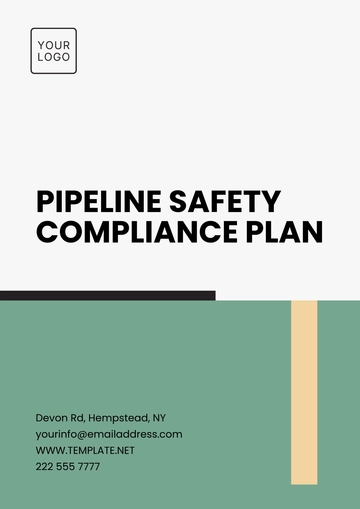Free Health & Safety Legal Compliance Plan Document
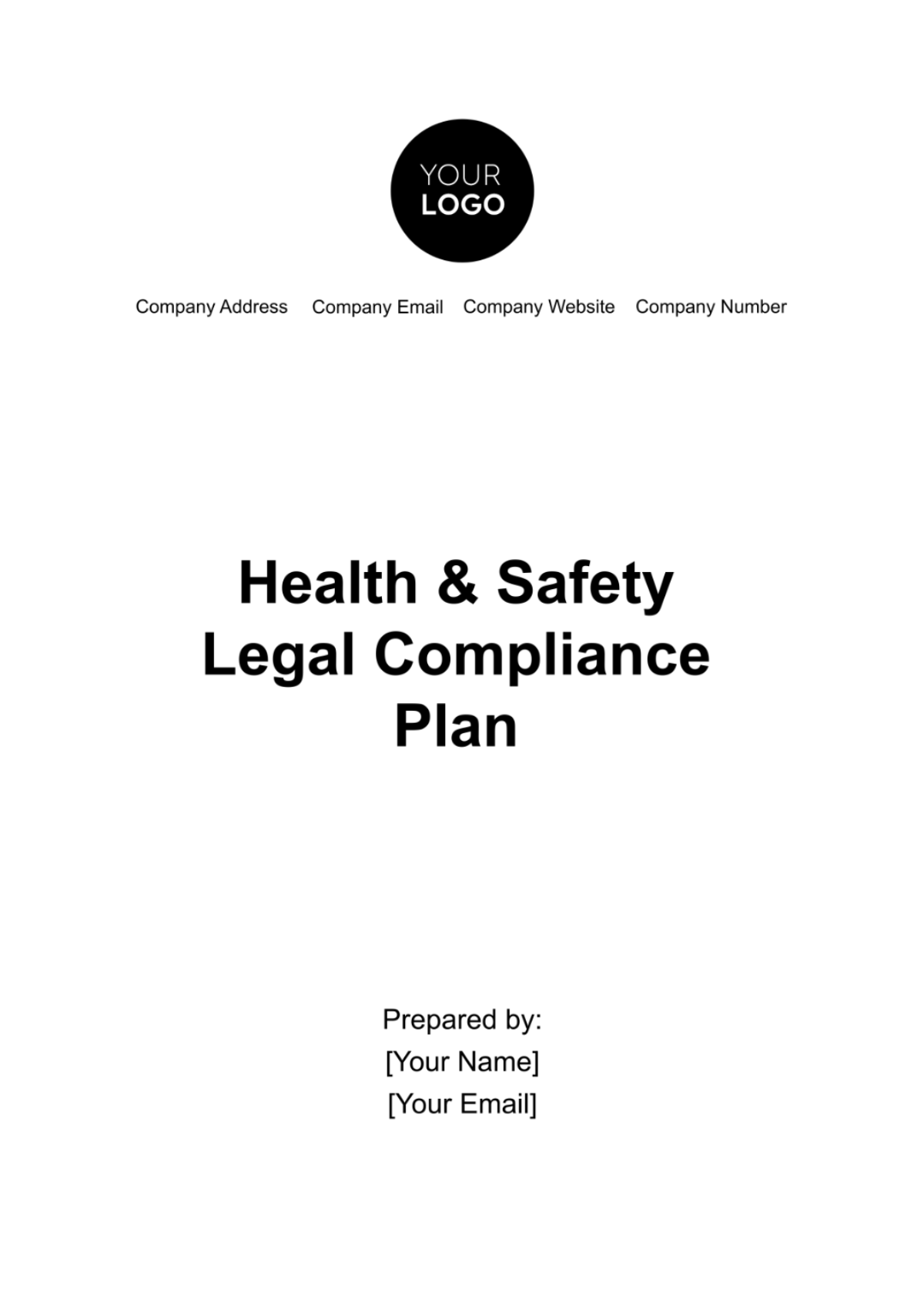
I. Executive Summary
Our commitment to maintaining a safe and healthy workplace is encapsulated in this plan. This plan outlines our strategic approach to ensure compliance with pertinent health and safety regulations while prioritizing the well-being of our workforce. At the core of our objectives is the creation of a secure environment that not only meets but exceeds legal requirements, fostering a culture of continuous improvement. Key components of the plan include rigorous risk assessment strategies, a well-defined organizational structure, and a thoughtfully allocated budget. As we embark on this journey, we aim not just to comply with regulations but to instill a proactive and vigilant approach to health and safety within our company culture.
II. Introduction
A. Purpose
This plan is crafted with the primary purpose of establishing a comprehensive framework to ensure the well-being of our workforce while maintaining strict adherence to relevant health and safety regulations. It serves as a guiding document that outlines our commitment to creating and sustaining a secure working environment.
B. Scope
The scope of this plan encompasses all aspects of our company's operations, from daily activities to long-term projects. It extends to cover the well-being of every employee, visitor, and stakeholder associated with our company. By defining the scope, we aim to address health and safety considerations across the entire spectrum of our activities.
C. Objectives
1. Enhance Workplace Safety
The first objective is to systematically enhance workplace safety by identifying potential hazards, implementing preventive measures, and ensuring that our facilities and processes align with the highest safety standards.
2. Ensure Legal Compliance
Our second objective is to ensure meticulous compliance with all applicable health and safety laws and regulations. This involves staying abreast of legislative changes, conducting regular audits, and adapting our practices to meet or exceed the legal requirements.
3. Foster a Culture of Safety
The third objective revolves around fostering a culture of safety among our workforces. This includes promoting awareness, providing comprehensive training programs, and encouraging active participation in health and safety initiatives. By instilling a sense of collective responsibility, we aim to create a workplace where safety is a shared value embraced by every member of our company.
III. Legal Framework
A. Overview of Health and Safety Laws
Our company operates within the jurisdiction of federal health and safety laws, including the Occupational Safety and Health Act (OSHA). These regulations set standards for workplace safety, covering aspects such as hazard communication, personal protective equipment, and emergency action plans.
B. Applicability to the company
Health and safety laws directly impact our company in areas such as manufacturing, office operations, and employee well-being. Non-compliance poses risks such as regulatory fines, legal actions, and reputational damage. To ensure adherence, regular assessments will be conducted to align policies with current legal requirements.
C. Regular Updates on Legislation
The Health and Safety Department will regularly monitor updates from OSHA and other relevant regulatory bodies. Monthly briefings and training sessions will be conducted to educate key personnel on changes in legislation. This proactive approach ensures our continued commitment to compliance and minimizes the risk of regulatory penalties.
IV. Organizational Structure
A. Key Personnel Roles
1. Health and Safety Officer (HSO)
Responsible for conducting monthly workplace inspections, identifying hazards, and ensuring compliance with health and safety regulations.
2. Emergency Response Coordinator (ERC)
Develops and oversees emergency response plans, conducts drills, and coordinates communication during emergencies.
3. Training Coordinator
Manages and tracks employee training programs, ensuring that employees are adequately trained on safety procedures and protocols.
B. Cross-Departmental Collaboration
Monthly safety meetings will involve representatives from each department, fostering collaboration and sharing safety information.
Department heads will actively participate in disseminating health and safety information to their teams, promoting a culture of shared responsibility.
A cross-functional health and safety committee will be established, composed of members from different departments to address company-wide safety matters.
C. Communication Protocols
Incident reports will be submitted through an online platform accessible to all employees, ensuring timely reporting and resolution.
Monthly safety newsletters will be circulated via email, providing updates on safety initiatives, sharing success stories, and reinforcing key safety messages.
An open-door policy will be maintained to encourage employees to report safety concerns directly to their supervisors or the Health and Safety Officer without fear of reprisal.
V. Risk Assessment
A. Comprehensive Hazard Identification
Regular workplace inspections will include the identification of hazards such as exposed wiring, slippery surfaces, and malfunctioning equipment.
Employees will be encouraged to use the suggestion box for safety concerns, providing an additional avenue for hazard identification.
Collaboration with external safety consultants will occur annually to ensure a comprehensive assessment of potential risks.
B. Risk Mitigation Strategies
Engineering controls, such as installing safety guards on machinery and implementing proper ventilation systems, will be employed to mitigate workplace hazards.
Administrative measures will include establishing clear safety protocols, conducting regular safety meetings, and designating emergency evacuation routes.
Personal protective equipment (PPE) will be provided, including gloves, safety goggles, and hard hats, to minimize the impact of identified risks on employees.
C. Periodic Risk Reviews
Bi-annual reviews of risk assessments will involve employees through surveys and feedback sessions to gather insights into potential risks.
Findings and recommendations will be documented and shared with relevant departments to facilitate continuous improvement.
Necessary changes based on review outcomes will be implemented promptly to enhance safety protocols and mitigate emerging risks.
VI. Health and Safety Policies
A. Policy Development
Our commitment to safety is reflected in the development of comprehensive health and safety policies, tailored to our company's unique operations and risks.
Policies cover critical areas including hazard reporting, proper use of personal protective equipment (PPE), emergency response procedures, and employee wellness.
Communication of policies will be through employee handbooks, dedicated training sessions, and prominently displayed signage.
B. Procedures for Incident Reporting
Clear and straightforward incident reporting procedures will be established, emphasizing prompt reporting and non-punitive measures to encourage openness.
A designated reporting platform will be implemented, ensuring all employees are aware of reporting channels and facilitating thorough investigations.
Disciplinary actions for non-compliance will be outlined, emphasizing fair and consistent consequences for violations.
C. Disciplinary Actions for Non-Compliance
Disciplinary actions will be fair, consistent, and proportionate to the severity and frequency of violations.
Communication of disciplinary measures will stress the importance of adherence to safety protocols.
VII. Training and Education
A. Training Programs
1. Emergency Response Training
This program equips employees with the necessary skills to respond swiftly and effectively to emergencies, including first aid, CPR, and evacuation procedures.
2. Hazard Communication Training
This program aims to provide comprehensive knowledge on the identification and communication of workplace hazards. Moreover, it ensures that employees understand safety data sheets, chemical labels, and potential risks associated with hazardous substances.
3. Workplace Ergonomics Training
Focused on preventing musculoskeletal disorders and promoting a healthy work environment, this training program educates employees on ergonomic practices, proper workstation setup, and techniques to minimize physical strain.
4. Safety Equipment Operation Training
This program aims to impart the necessary skills for the correct usage of safety equipment, including personal protective gear and machinery-specific safety measures, ensuring employees can operate equipment safely and reduce the risk of accidents.
B. Training Frequency
The table below outlines the frequency of training programs to ensure ongoing competence and awareness among employees:
Training Program | Frequency |
Emergency Response Training | [Biannual] |
Hazard Communication Training | [Annual] |
Workplace Ergonomics Training | [Every 2 years] |
Safety Equipment Operation Training | [Annual] |
All of these training programs cover various aspects of health and safety. Emergency response training is conducted biannually to reinforce crucial life-saving skills and adapt to evolving emergency protocols. An annual refresher for hazard communication is also conducted to stay current with regulatory changes, ensuring employees remain well-informed about potential workplace hazards.
The varied frequency of these programs ensures continuous skill development and adaptation to evolving safety standards, contributing to the overall health and safety of the workplace.
C. Documentation of Training Records
Thorough maintenance of training records will include attendance, topics covered, and assessment results.
Accessible records will facilitate audits and serve as a valuable resource for tracking employee competence.
Periodic review and update of training materials will reflect changes in regulations and company processes.
VIII. Emergency Response Plan
A. Emergency Procedure
Communication during emergencies will be facilitated through alarms, intercom systems, and designated emergency coordinators, ensuring swift dissemination of critical information.
B. Evacuation Plans and Assembly Points
Evacuation plans and assembly points are meticulously designated, marked, and will be communicated to all employees.
2. Regular drills are conducted to ensure employees are familiar with evacuation procedures, routes, and assembly points.
A robust communication protocol is in place to account for all employees during evacuations and emergencies, ensuring their safety and well-being.
C. Communication Protocols During Emergencies
Various communication channels, including alarms and intercom systems, are regularly tested and maintained to address any potential issues.
Clear lines of communication are established, designating emergency coordinators to coordinate and relay critical information, further ensuring the safety of all personnel.
IX. Budget
The following table and graph outline the budget allocation for implementing the compliance plan:
Item | Allocation |
Health and Safety Training | $25,000 |
Total Budget | $25,000 |
A well-allocated budget not only supports compliance but also reinforces our commitment to creating a secure and healthy work environment for all stakeholders. The allocated budget encompasses various components aimed at fortifying our commitment to ensure compliance. It reflects our dedication to proactively invest in the well-being of our employees and the overall success of our company.
X. Monitoring and Evaluation
A. Audits and Inspections
Quarterly internal audits will be led by the Health and Safety Officer, focusing on high-risk areas identified through previous inspections.
Monthly workplace inspections, targeting specific safety concerns within their respective areas, will be performed by department heads.
The findings of audits and inspections, including identified hazards and recommended corrective actions, will be documented and shared during monthly safety meetings to enhance transparency and facilitate collaborative problem-solving.
B. Incident Review Process
A dedicated Incident Review Board composed of the Health and Safety Officer, Emergency Response Coordinator, and relevant department heads will be established.
Bi-monthly incident review meetings will be scheduled to thoroughly analyze root causes, contributing factors, and lessons learned from reported incidents.
Corrective actions based on the outcomes of incident analysis will be implemented promptly, ensuring efficient communication of changes to relevant departments and tracking resolution progress.
C. Key Performance Indicators (KPIs)
1. Safety Training Completion Rate
Percentage of employees who have completed required safety training within the designated time frame.
2. Incident Response Time
Average time taken to respond to and address reported incidents or safety concerns.
3. Compliance Percentage
Percentage of employees adhering to established safety protocols and procedures.
4. Number of Near Misses Reported
The total count of near misses reported by employees within a specified period.
5. Emergency Drill Effectiveness
Evaluation of the effectiveness of emergency response drills based on predefined criteria.
XI. Continuous Improvement
A. Employee Feedback Mechanism
A structured feedback mechanism, including anonymous suggestion boxes, bi-annual safety surveys, and quarterly focus group discussions, will be implemented.
An accessible online platform for real-time reporting of safety concerns, managed by the Health and Safety Committee, will be established.
The Health and Safety Committee will be responsible for collating and analyzing employee feedback, implementing changes, and providing regular updates on resolution progress through targeted communication channels.
B. Incident Analysis and Lessons Learned
Scheduled incident analysis workshops, involving representatives from relevant departments, will be conducted bi-annually to ensure comprehensive insights.
Lessons learned will be shared through informative bulletins and regular safety meetings, leveraging multiple communication channels for company learning.
A knowledge-sharing platform will be developed to systematically document and distribute incident analysis outcomes throughout the company, promoting awareness and continuous improvement.
Regular Plan Reviews
Quarterly reviews of the Health & Safety Legal Compliance Plan, led by the Health and Safety Officer and involving the active participation of the Health and Safety Committee, will be scheduled.
XII. Conclusion
Our plan stands as a steadfast commitment to the well-being of our workforce and the sustainability of our company. By meticulously addressing legal frameworks, fostering cross-departmental collaboration, and implementing robust risk assessment strategies, we lay the foundation for a safety-centric culture. Through continuous monitoring, dynamic policies, and strategic KPIs, our company is poised not only to meet compliance standards setting a standard for excellence in occupational health and safety. As we embark on this journey, our dedication to safety underscores not just an obligation but a core value, ensuring a secure and resilient future for all stakeholders.
- 100% Customizable, free editor
- Access 1 Million+ Templates, photo’s & graphics
- Download or share as a template
- Click and replace photos, graphics, text, backgrounds
- Resize, crop, AI write & more
- Access advanced editor
Build a robust fortress of compliance with our adaptable Health & Safety Legal Compliance Plan Document Template from Template.net! This versatile tool empowers you to not just meet but surpass legal expectations. Craft policies effortlessly, tailoring your strategy to foster a culture of safety. Stay ahead in legal matters today with ease!
You may also like
- Finance Plan
- Construction Plan
- Sales Plan
- Development Plan
- Career Plan
- Budget Plan
- HR Plan
- Education Plan
- Transition Plan
- Work Plan
- Training Plan
- Communication Plan
- Operation Plan
- Health And Safety Plan
- Strategy Plan
- Professional Development Plan
- Advertising Plan
- Risk Management Plan
- Restaurant Plan
- School Plan
- Nursing Home Patient Care Plan
- Nursing Care Plan
- Plan Event
- Startup Plan
- Social Media Plan
- Staffing Plan
- Annual Plan
- Content Plan
- Payment Plan
- Implementation Plan
- Hotel Plan
- Workout Plan
- Accounting Plan
- Campaign Plan
- Essay Plan
- 30 60 90 Day Plan
- Research Plan
- Recruitment Plan
- 90 Day Plan
- Quarterly Plan
- Emergency Plan
- 5 Year Plan
- Gym Plan
- Personal Plan
- IT and Software Plan
- Treatment Plan
- Real Estate Plan
- Law Firm Plan
- Healthcare Plan
- Improvement Plan
- Media Plan
- 5 Year Business Plan
- Learning Plan
- Marketing Campaign Plan
- Travel Agency Plan
- Cleaning Services Plan
- Interior Design Plan
- Performance Plan
- PR Plan
- Birth Plan
- Life Plan
- SEO Plan
- Disaster Recovery Plan
- Continuity Plan
- Launch Plan
- Legal Plan
- Behavior Plan
- Performance Improvement Plan
- Salon Plan
- Security Plan
- Security Management Plan
- Employee Development Plan
- Quality Plan
- Service Improvement Plan
- Growth Plan
- Incident Response Plan
- Basketball Plan
- Emergency Action Plan
- Product Launch Plan
- Spa Plan
- Employee Training Plan
- Data Analysis Plan
- Employee Action Plan
- Territory Plan
- Audit Plan
- Classroom Plan
- Activity Plan
- Parenting Plan
- Care Plan
- Project Execution Plan
- Exercise Plan
- Internship Plan
- Software Development Plan
- Continuous Improvement Plan
- Leave Plan
- 90 Day Sales Plan
- Advertising Agency Plan
- Employee Transition Plan
- Smart Action Plan
- Workplace Safety Plan
- Behavior Change Plan
- Contingency Plan
- Continuity of Operations Plan
- Health Plan
- Quality Control Plan
- Self Plan
- Sports Development Plan
- Change Management Plan
- Ecommerce Plan
- Personal Financial Plan
- Process Improvement Plan
- 30-60-90 Day Sales Plan
- Crisis Management Plan
- Engagement Plan
- Execution Plan
- Pandemic Plan
- Quality Assurance Plan
- Service Continuity Plan
- Agile Project Plan
- Fundraising Plan
- Job Transition Plan
- Asset Maintenance Plan
- Maintenance Plan
- Software Test Plan
- Staff Training and Development Plan
- 3 Year Plan
- Brand Activation Plan
- Release Plan
- Resource Plan
- Risk Mitigation Plan
- Teacher Plan
- 30 60 90 Day Plan for New Manager
- Food Safety Plan
- Food Truck Plan
- Hiring Plan
- Quality Management Plan
- Wellness Plan
- Behavior Intervention Plan
- Bonus Plan
- Investment Plan
- Maternity Leave Plan
- Pandemic Response Plan
- Succession Planning
- Coaching Plan
- Configuration Management Plan
- Remote Work Plan
- Self Care Plan
- Teaching Plan
- 100-Day Plan
- HACCP Plan
- Student Plan
- Sustainability Plan
- 30 60 90 Day Plan for Interview
- Access Plan
- Site Specific Safety Plan
